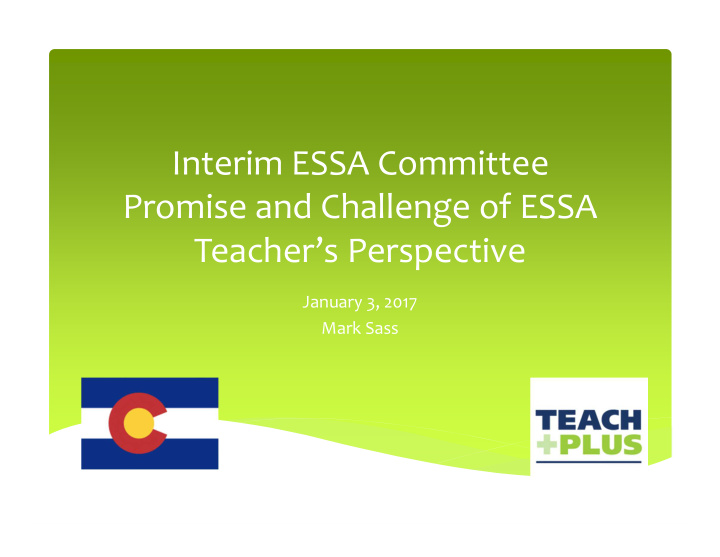



Interim ESSA Committee Promise and Challenge of ESSA Teacher’s Perspective January 3, 2017 Mark Sass
A Teacher’s Perspective ∗ Teaching as a third profession ∗ Classroom Teacher Ambassador for the U.S. Department of Education (2015-16). ∗ Colorado State Policy Director for Teach Plus ∗ 21-year teacher of high school social studies
Teacher’s Understanding of ESSA ∗ Limited to those who have taken an interest in education policy. ∗ Teachers are eager to address the education system that reflects the demands of the 21 st Century. (Innovation) ∗ As professionals, teachers care deeply about issues of equity and excellence. (Equity)
Standards ∗ Promising: Colorado Academic Standards meet/exceed ESSA Requirements. ∗ This allows teachers to continue to engage with the standards in order to build curriculum and assessments that align to the standards. ∗ Challenge: If standards are changed ∗ Don’t throw out all of the work done.
Assessments ∗ ESSA continues to mandate annual testing, but also includes incentives for states and districts to audit the amount and move towards fewer, better exams. (SMART Act) ∗ Encouraged by the possibilities of alternative forms of assessments through the pilot legislation passed last year. ∗ Like the possibility of performance-based assessments that evaluate higher order thinking skills. ∗ Challenge: Long-term process
Opt Out ∗ Teachers dismayed at the impact opt out had on school accountability under NCLB ∗ Promising: States can decide the impact of missing the 95% opt out in the state’s accountability system.
Accountability ∗ Teachers want to ensure all students are prepared for college and career. One good aspect of NCLB is the mandatory disaggregation of student data. ESSA continues this. ∗ Allows teachers to act on achievement gaps.
Indicators of School Quality or Student Success Along with academic achievement, academic growth in elementary/middle, high school graduation rates, and ELL proficiency gains, states can use at least one other valid, reliable, comparable statewide indicator of “school quality or student success” in accountability systems.
Examples of SQSS ∗ Student, parent, educator engagement (survey) ∗ Access to/completion of advanced coursework, tech courses, etc. ∗ Post-secondary readiness ∗ School climate ∗ Well-rounded curriculum, access to arts and other programs ∗ Current recommendation of chronic absenteeism troublesome to some teachers
Title II Part A and Teacher Leadership ∗ Thanks to Sen. Bennet for pushing language in Title II to better spend these dollars. ∗ Title IIA funds can be used to attract, support, and retain effective teachers. ∗ State allocated @ $24 million 16-17 SY ∗ ESSA broadens allowable uses to create teacher leadership pathways.
ESSA Redefines Standards for PD ∗ NCLB defined PD in very general terms: “Activities that improve teacher’s knowledge in the subjects they teach, allow them to become HQ, and advance their understanding of instructional strategies.” ∗ ESSA redefines PD as: “Activities that are sustained [not stand-alone, 1-day, or short-term workshops], intensive, collaborative, job-embedded, data-driven, and classroom focused.” ∗ What can the state do to encourage districts to follow this guideline, which could lead to a more sustained, personalized, and evidence-based PD?
Teacher Advisory Council ∗ A survey of teachers in Colorado showed less than 7% felt they had a voice in state education policy. ∗ Up to 4% of Title II funds can be used for state activities. ∗ Create a non-partisan, apolitical council of teachers from around the state to provide feedback to/from policymakers to/from their communities.
Teachers’ Hopes with ESSA ∗ ESSA provides flexibility, which can promote innovation. ∗ Focus on equity through excellence ∗ Balance local decision making with statewide goals ∗ Recognize this all takes time
Thank you ∗ More teachers at the table! ∗ Please visit our classrooms!
Recommend
More recommend